|
Ciconia ciconia (White stork)
Witooievaar [Afrikaans]; Ingwamza, Unowanga [Xhosa];
uNogolantethe, uNowanga [Zulu]; Nkumbinkumbi [Kwangali]; Mokoroane (also applied
to Black stork), Mokotatsie (also applied to Yellow-billed stork) [South Sotho];
Leakaboswana le leÜweu [North Sotho]; Gumba, Ntsavila, Xaxari [Tsonga]; Lek˘l˘lwane,
Mok˘tatsiŕ (these terms also applied to Abdim's stork [Tswana]; (gewone)
ooievaar [Dutch]; Cigogne blanche [French]; Wei▀storch [German]; Cegonha-branca
[Portuguese]
Life
> Eukaryotes >
Opisthokonta
> Metazoa (animals) >
Bilateria >
Deuterostomia > Chordata >
Craniata > Vertebrata (vertebrates) > Gnathostomata (jawed
vertebrates) > Teleostomi (teleost fish) > Osteichthyes (bony fish) > Class:
Sarcopterygii (lobe-finned
fish) > Stegocephalia (terrestrial
vertebrates) > Tetrapoda
(four-legged vertebrates) > Reptiliomorpha > Amniota >
Reptilia (reptiles) >
Romeriida > Diapsida > Archosauromorpha > Archosauria >
Dinosauria
(dinosaurs) > Saurischia > Theropoda (bipedal predatory dinosaurs) >
Coelurosauria > Maniraptora > Aves
(birds) > Order: Ciconiiformes > Family: Ciconiidae
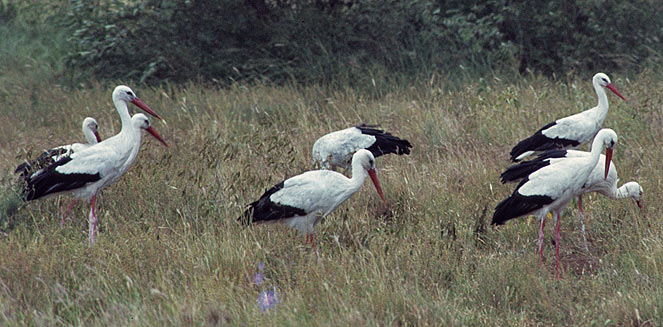 |
|
White storks. [photo H. Robertson, Iziko
ę] |
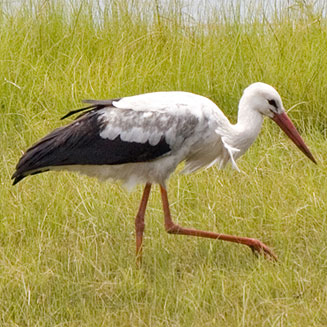 |
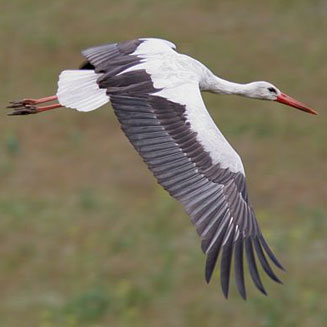 |
|
White stork. [photo
Neil Gray
ę] |
White stork, Ntsikeni Nature Reserve, South
Africa. [photo Trevor Hardaker ę] |
Distribution and habitat
Breeds in parts of Eurasia and North Africa, heading south
in the non-breeding season to sub-Saharan Africa. In southern Africa, it is common to abundant in Zimbabwe,
Botswana, Namibia, Mozambique and South Africa, largely excluding the arid Karoo. It has a small breeding population in the Western
Cape. It generally prefers open woodland, grassy Karoo, grassland, wetlands and
cultivated land.
|
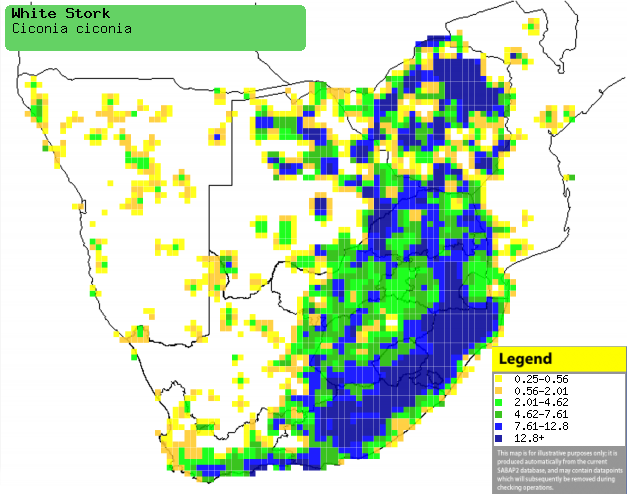 |
|
Distribution of White stork in southern Africa,
based on statistical smoothing of the records from first SA Bird Atlas
Project (ę
Animal Demography unit, University of
Cape Town; smoothing by Birgit Erni and Francesca Little). Colours range
from dark blue (most common) through to yellow (least common).
See here for the latest distribution
from the SABAP2. |
Movements and migrations
Mostly a palearctic breeding migrant, leaving
its Eurasian breeding grounds to travel south all the way to southern
Africa, where it stays from October-May. It is also a breeding
resident in parts of the Western Cape, from the Agulhas Plain to
Mossel Bay, although juveniles may join migrants in their trip
north.
Food
It eats a variety of insects and small vertebrates, doing
most of its foraging in spread out groups, slowly moving through vegetation in
search of prey. The following food items have been recorded
in its diet:
- Invertebrates
- insects
-
caterpillars (larval stage of
Lepidoptera)
- Spodoptera exempta (Armyworms)
- Heliothis armigera (American bollworm)
- Imbrasia belina (Mopane emperor moth)
-
Orthoptera (crickets, locusts and grasshoppers)
- Locustana pardalina (Brown locust)
- molluscs
-
scorpions
- Vertebrates
- mice
- small reptiles
- amphibians
- fish
- carrion
- bird chicks
Breeding
- Monogamous solitary nester. The male selects a nest site and often mates with the
first female to arrive.
- The nest (see image below) is built by both sexes in roughly a week,
consisting of a large platform of reeds, sticks and clods of earth and
grass. It is typically placed on a tree in an open area, especially on an
alien tree such as Rooikrans (Acacia cyclops), Eucalyptus or White milkwood (Sideroxylon inerme);
it also uses man-made structures, such
as broken chimneys.
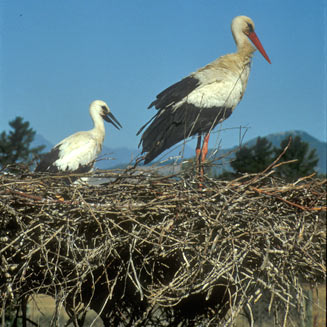 |
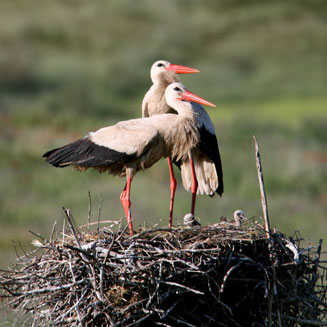 |
|
White stork adult and chick, sitting on their
nest. [photo Peter Steyn] |
White storks at their nest, Spain. [photo
Mike Grimes ę] |
- Egg-laying season is from September-November.
- It lays 1-6 eggs, which are incubated by incubated by both sexes for
roughly 30 days.
- The chicks are fed by both parents and brooded for up to ten days,
leaving the nest at about 45-70 days old and becoming fully independent
roughly 7-20 days later.
Threats
Not globally threatened, although its breeding range has
decreased in Europe.
References
-
Hockey PAR, Dean WRJ and Ryan PG 2005. Roberts
- Birds of southern Africa, VIIth ed. The Trustees of the John Voelcker
Bird Book Fund, Cape Town.
-
Harrison, J.A., Allan, D.G., Underhill, L.G., Herremans, M.,
Tree. A.J., Parker, V. & Brown, C.J. (eds). 1997. The atlas of southern
African birds. Vol. 2: Passerines. BirdLife South Africa, Johannesburg.
|
